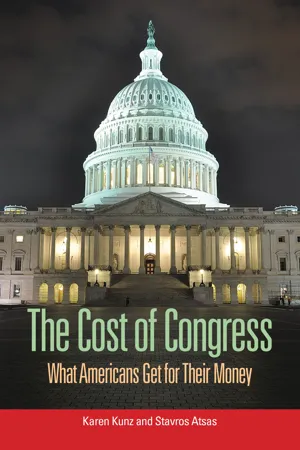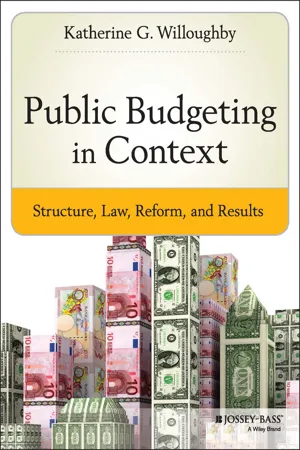Politics & International Relations
Power of the Purse
Power of the Purse refers to the ability of the legislative branch to control government spending by approving or denying budgets and appropriations. This power is a key aspect of the system of checks and balances in democratic governments, as it allows the legislature to limit the power of the executive branch and ensure that public funds are used in accordance with the will of the people.
Written by Perlego with AI-assistance
Related key terms
3 Key excerpts on "Power of the Purse"
- eBook - ePub
America's National Debt
Examining the Facts
- Thomas Arndt(Author)
- 2022(Publication Date)
- ABC-CLIO(Publisher)
3 Congress and the Power of the PurseThere are certain fundamental powers that any country or government must be prepared to contend with and carry out effectively. In addition to basic powers of law enforcement or “police powers” to regulate affairs within one’s own sovereign borders, governments exercise “power of the sword,” referring to a country’s capabilities to engage in military conflict with foreign actors. Crucially, however, for the purposes of this chapter, there is also what has come to be known as the “Power of the Purse,” referring to the task of managing public financial issues, including both taxing and spending. In the United States, this power is reserved almost entirely for the legislative branch of government, as is the case in nearly all democratically inspired political systems.In the United States, popularly elected lawmakers are in charge of deciding how to both raise revenue for the federal government and spend tax dollars. These roles for the national legislature are clearly set forth in Article 1 of the U.S. Constitution. To be more specific, Section 7, Clause 1, states that “All Bills for raising Revenue shall originate in the House of Representatives; but the Senate may propose or concur with amendments as on other Bills.” Section 9, Clause 7, goes on to assert that “No Money shall be drawn from the Treasury, but in Consequence of Appropriations made by Law; and a regular Statement and Account of the Receipts and Expenditures of all public Money shall be published from time to time.”The spending of money by Congress is an issue of paramount importance and is ever present in the country’s politics. In fact, it looms large over every other policy issue that can be imagined. Even the power of the sword, which is often considered to be the most consequential of all governmental powers (due to the direct impact on matters of life and death), requires the Power of the Purse to make it all possible. Armies and navies are unable to march or sail to war if they lack sufficient financial power to back them up. Similarly, funding for education, transportation, national parks, social welfare programs like Medicare and Social Security, and scientific research, to name but a few areas, all come from Congress. Clearly, the power to spend permeates nearly all social and political action. Alexander Hamilton alluded to this in numerous instances throughout his career. In a letter to James Duane in 1780, he criticized the lack of purse string powers held by the Congress of the Confederation under the Articles of Confederation (America’s initial failed attempt at a constitution) by insisting that it deserved “perpetual funds … appropriated to [Congress’s] use, for without certain revenues, a government can have no power; that power, which holds the purse strings absolutely, must rule” (Hamilton, 1780). - eBook - ePub
The Cost of Congress
What Americans Get for Their Money
- Karen Kunz, Stavros Atsas(Authors)
- 2022(Publication Date)
- Praeger(Publisher)
CHAPTER SIXThe Power of the PurseThe framers vested Congress with the Power of the Purse by providing in the Constitution that “[n]o Money shall be drawn from the Treasury, but in Consequence of Appropriations made by Law.” As James Madison explained, the framers did so for two primary reasons. First, this arrangement ensured that the government remained directly accountable to the will of the people: “power over the purse may, in fact, be regarded as the most complete and effectual weapon with which any constitution can arm the immediate representatives of the people, for obtaining a redress of every grievance, and for carrying into effect every just and salutary measure.” Second, Congress through its Power of the Purse holds a key check on the power of the other branches, allowing it to reduce “all the overgrown prerogatives of the other branches of government.”The meaning of the Appropriations Clause is straightforward: No money can be paid out of the Treasury unless it has been appropriated by an act of Congress. Congress’s Power of the Purse vests in Congress the power and duty to affirmatively authorize all expenditures, and the Constitution provides Congress with the power to enact statutes to protect and exercise this power. Congress has largely done this through the annual budget and appropriations process and a series of permanent statutes that establish controls on the use of appropriated funds.— Letter from Thomas Armstrong, General Counsel for GAO, to Chairman John Yarmuth and Ranking Member Steve Womack, House Committee on the Budget. Testimony before the House Committee on the Budget—Congress’s Constitutional Power of the Purse and the Government Accountability Office’s Role to Serve that Power.The quote above is derived from Congressional testimony, during which the GAO’s General Counsel reminded the House Budget Committee of Congress’s utmost priority. While a bit long, it clearly illustrates Congress’s constitutionally bound roles and responsibilities in managing taxpayers’ dollars and funding federal government. - eBook - ePub
Public Budgeting in Context
Structure, Law, Reform and Results
- Katherine G. Willoughby(Author)
- 2014(Publication Date)
- Jossey-Bass(Publisher)
Chapter Seven Budget Powers of the Legislative BranchDetermining the allocation of resources among competing claims was critical to establishing the legitimacy and authority of the legislature as an institution competing with the monarchy.—Paul Posner and Chung-Keun Park, Role of the Legislature in the Budget Process: Recent Trends and InnovationsLEARNING OBJECTIVES
After reading this chapter, you should be able to- Distinguish between presidential and parliamentary systems of government
- Measure the budget powers of legislatures
- Compare the budget powers and processes of legislatures by governance structure and level of government
- Understand reforms governments engage to balance budget powers across different branches of government
- Find and analyze budget institutional and process data about governments of interest
Legislative bodies, as representative institutions, serve as the fundamental connection of people with their government. Well-working governmental systems have legislatures that establish policy (make laws), determine the means for accomplishing policy goals (produce budgets), and conduct oversight of policy execution (evaluate spending). The “Power of the Purse” (the means for accomplishing policy goals) is a constitutionally established responsibility of parliaments and legislatures in governments around the world and the most important feature of a governmental system. The Power of the Purse is the ability to generate revenues, decide on taxes, and determine how and where public funds will be spent. The ability of legislatures to make laws and budgets and evaluate spending arises not just from constitutions and code, but also from the evolution of institutional organizational arrangements, procedural systems and rules, technical and research support, and the influences of culture and tradition. These factors and the state of modern legislative budgeting are discussed in this chapter.
Index pages curate the most relevant extracts from our library of academic textbooks. They’ve been created using an in-house natural language model (NLM), each adding context and meaning to key research topics.


